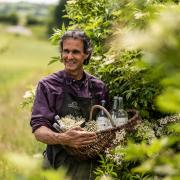Rosie Sanders is a Master painter. I say that rarely, but in Rosie’s case it is understood. At 80 years old, she has the vibrancy and focus of an artist still pushing the boundaries of her creative enquiry, and still exploring and refining the possibilities of her materials.
Rosie is known primarily as a painter of exquisite botanical watercolours which go far beyond the genre of illustrative art. In their colour, composition and extremity of scale, they take botanical painting into the realm of interpretive art, heightening our appreciation of the beauty of the natural world.
She is particularly admired for her studies of roses, as exhibited over two decades at Jonathan Cooper Gallery in Chelsea, and which are the subject of her well-known book Roses: A Celebration in Botanical Art.
Her lovely Georgian home on the edge of Dartmoor is part studio, part gallery, part domestic space. It is a place where painting easels and printing presses merge with comfortable sofas, elegant antiques and her own, exemplary collection of 20th and 21st century ceramics.

In a space overlooking her garden, which is a riot of flowers, Rosie shows me a series of works that contrast the summer colour outside. These dramatic, charcoal on paper drawings show a very different side to her work, and are inspired by Dartmoor’s bleak and beautiful landscape. They are destined for her Spirit of Place exhibition, on show this October at Green Hill Arts in Moretonhampstead.
In particular, this collection explores the sculptural qualities of trees, against the curving lines of the moor or mirrored in the dark waters of its mysterious pools. They are eerily beautiful, and seem to complete the seasonal circle of artworks in this house, from grand paintings of summer flowers to small, hand-painted books of autumnal berries, to drawings of winter’s bare branches. But from this artist, I suspect, there is still much more to come.
greenhillarts.co.uk
rosiesanders.com



























